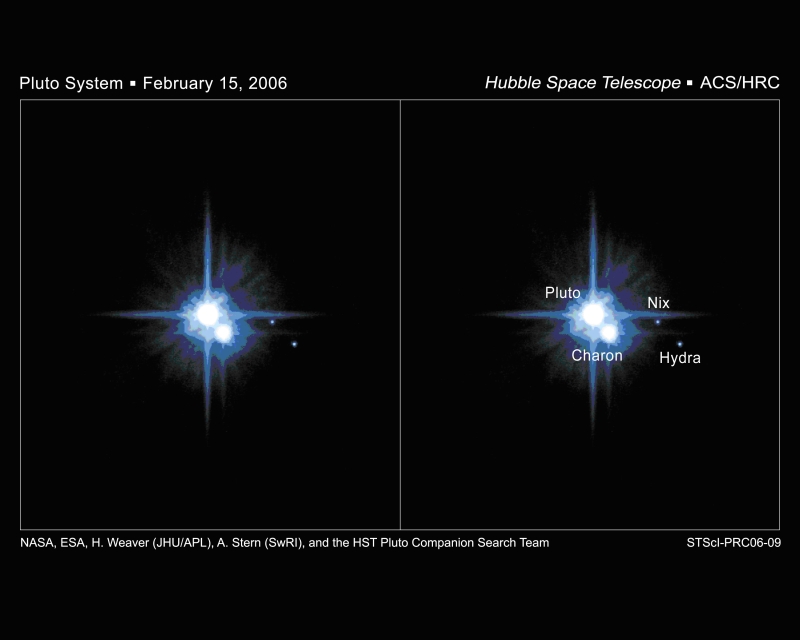
The International Astronomical Union approved new names for Pluto’s recently discovered tiny moons. Previously designated S/2005 P 1 and 2, the moons will now bear the names Hydra and Nix. In mythology, Nix is the goddess of darkness and night, while the hydra is a monster with the body of a serpent and nine heads. Although they’re faint dots right now, NASA’s New Horizons probe will fly pas them in 2015, and map them in much more detail.
The names Nix and Hydra have been approved for the two small satellites of Pluto discovered in May 2005. The International Astronomical Union (IAU), the internationally recognized authority for assigning designations to celestial bodies, approved the names this week.
A team of researchers from Southwest Research Institute (SwRI), the Johns Hopkins University Applied Physics Laboratory (APL), the Space Telescope Science Institute and Lowell Observatory used Hubble Space Telescope images to make the discovery in support of NASA’s New Horizons mission to Pluto and the Kuiper Belt beyond.
“We’re very pleased with the decision of the IAU,” says co-leader of the discovery team and New Horizons Principal Investigator Dr. Alan Stern of SwRI. “You’re going to be hearing a lot more about Nix and Hydra in coming years — astronomers are already applying for telescope time to study their orbits and physical properties. And when New Horizons flies by Pluto in the summer of 2015, each will be mapped in detail.”
“Pluto doesn’t reveal its moons easily,” adds team co-leader and New Horizons Project Scientist Dr. Hal Weaver of APL. “It took 48 years after the discovery of Pluto to find Charon and another 27 years to find Nix and Hydra. Perhaps we won’t have to wait as long for the next discovery because the New Horizons spacecraft will be making a rendezvous with Pluto in nine years and will be searching for other small satellites.”
Nix and Hydra, roughly 5,000 times fainter than Pluto itself, are about two to three times as far from Pluto as its large moon, Charon, which was discovered in 1978. The nine-member discovery team selected the name Nyx for S/2005 P 2, the inner small satellite, and the name Hydra for S/2005 P 1, the outer small satellite. Because asteroid 3908 already bears the Greek name Nyx, the IAU changed Nyx to its Egyptian equivalent, Nix.
In mythology, Nix is the goddess of darkness and night, befitting a satellite orbiting distant Pluto, the god of the underworld. Nix is also the mother of Charon, relevant to the giant impact believed to have created Pluto’s three satellites, indicating Charon was borne of the material from which Nix formed. Hydra is the terrifying monster with the body of a serpent and nine heads, befitting the outermost moon of Pluto, the ninth planet in the solar system.
In addition, just as Pluto’s name begins with the letters “P” and “L” to honor Percival Lowell, who motivated the search that led to its discovery, Nix and Hydra honor the search for new satellites and the New Horizons mission to Pluto by starting with the letters “N” and “H.” The first letter of Hydra also honors the Hubble Space Telescope that was used to detect the satellites.
Southwest Research Institute (SwRI) is an independent, nonprofit, applied research and development organization based in San Antonio, Tx., with more than 3,000 employees and an annual research volume of more than $435 million. For more information, visit http://www.swri.org.
The Applied Physics Laboratory (APL) is a not for profit laboratory and division of The Johns Hopkins University. APL conducts research and development primarily for national security and for nondefense projects of national and global significance. APL is located midway between Baltimore and Washington, D.C., in Laurel, Md. For more information, visit http://www.jhuapl.edu.
Original Source: SWRI News Release
Why is Pluto not a planet? Here’s some additional Pluto information. Here’s a link to the Hydra constellation.

how big are the new moons
Why bother to name the satellites if they didn’t think Pluto was a planet anyways? Answer:Pluto IS a planet…it has a stable orbit, it has an atmosphere, it has satellites (I know this would make mercury NOT a planet but it makes plute more of a planet than mercury).
Then Mercury shouldn’t be a planet, NOT Pluto. I love Pluto. STUPID scientists!! BE SMART! -_-
You, Josh, are correct!!
Josh is not correct!
I am above the law!
Well, first of all, Ginger and Team Josh, none of what you’ve described is relavant to wether a planet is a planet or not. It’s the size that counts. And I’d never thought of classifying Mercury as a Dwarf Planet, not a planet. Nice theory, but I’ve researched planets and Dwarf Planets and Pluto is just within the Dwarf Planet size restrictions and Mercury is just within the planet size restrictions.
Secondly, Nix and Hydra are part of our Solar System, therefore deserve names. Even the moons of 2003 EL61 – another Dwarf Planet – will be named eventually. As soon as 2003 EL61 gets a name itself, of course.
As my summary, Evanescence rule!
(They’re an alternative rock band, by the way.)
Oh, and Jovian, no one – and I mean NO ONE – is above the law.
You just got served by the white girl!
(A phrase me and my friends use.)
-geniusgirl_123
KissKiss!
Pluto is not a planet!!
Its orbit is totally wacko and it matches the characteristics of a comit better than those of a planet!
Face the facts and ditch pluto!!
I think that the new moons are really cool! =]
I can’t wait to find out more about them.
By the way, even though Pluto is not one of the nine main planets,technically it’s still a planet becasue it’s classified as a dwarf PLANET!
i lov pluto